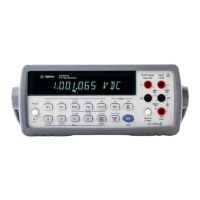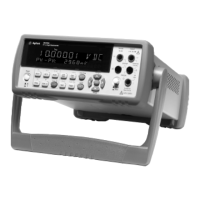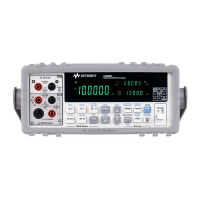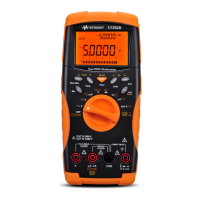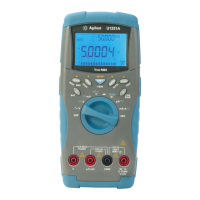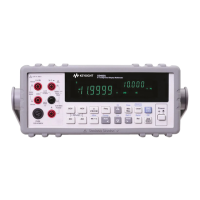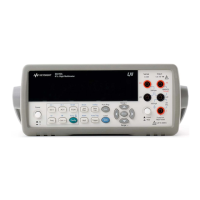Chapter 4 Making Measurements 105
Frequency or period measurements: The integration time does not affect
frequency or period measurements. For these measurements, the specified
resolution (which also selects gate time) has a major effect on the reading
rate. The specifications in Appendix A show reading rates for frequency and
period measurements based on the specified resolution.
Triggering Setup To ensure the fastest triggering configuration, set the trigger arm, trigger,
and sample events to AUTO, You can also use the TIMER sample event (or
the SWEEP command). Assuming you do not generate the TRIGGER TOO
FAST error, the reading rate is the reciprocal of the TIMER or SWEEP
interval.
Delay Time Under normal operation, the multimeter automatically determines a delay
time (default delay) based on the present measurement function, range,
resolution, and for AC measurements, the AC bandwidth setting. This delay
time is actually the settling time inserted before the first reading, which
ensures accurate readings. The default delay has a large affect on the reading
rate for analog AC measurements and a minimal affect on the reading rate
for sampled AC voltage or DC measurements. For analog AC measurements,
you can achieve a faster reading rate by specifying a shorter delay than the
default value. However, the resulting settling time may not produce accurate
measurements.
AC Bandwidth For the fastest AC measurements, specify the AC bandwidth (ACBAND
command) to match the frequency content of the input signal. The
specifications in Appendix A show the reading rates for AC measurements
based on the frequency components of the input signal.
Offset Compensation For 2- and 4-wire ohms measurements with offset compensation enabled, an
offset voltage measurement is made before each resistance reading. This
requires more time than with offset compensation disabled (OCOMP OFF).
High-Speed DCV
Example
The following program measures DC voltage at the fastest. possible rate (>
100k readings per second). The readings are stored in reading memory.
10 OUTPUT 722;"PRESET FAST" !DCV, 10V RANGE, TARM SYN, TRIG AUTO
20 OUTPUT 722;"APER 1.4E-6" !LONGEST INTEGRATION TIME POSSIBLE FOR
25 !>100K READINGS PER SECOND
30 OUTPUT 722;"MFORMAT SINT" !SINT MEMORY FORMAT
40 OUTPUT 722;"MEM FIFO" !ENABLE READING MEMORY
50 OUTPUT 722;"NRDGS 10000,AUTO !10000 READINGS/TRIGGER, AUTO SAMPLE EVENT
60 OUTPUT 722;"TARM SGL" !TRIGGER READINGS
70 END
High-Speed OHM (or
OHMF) Example
The following program measures 2-wire ohms at the fastest possible rate (>
100k readings per second). This program can be adapted to 4-wire ohms by
using the OHMF command instead of the OHM command in line 50.
10 OUTPUT 722;"PRESET FAST" !DCV 10V RANGE, TARM SYN, TRIG AUTO
20 OUTPUT 722;"APER 1.4E-6" !LONGEST INTEGRATION TIME POSSIBLE FOR
25 !>1OOK READINGS PER SECOND
30 OUTPUT 722;"MFORMAT SINT" !SINT MEMORY FORMAT
40 OUTPUT 722;"MEM FIFO" !ENABLE READING MEMORY
50 OUTPUT 722;"OHM 100E3" !2-WIRE OHMS, 100K(W) RANGE
60 OUTPUT 722;"NRDGS 10000,AUTO" !10000 READINGS/TRIGGER, AUTO SAMPLE EVENT
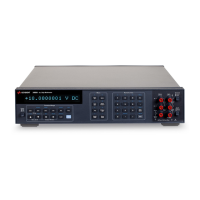
